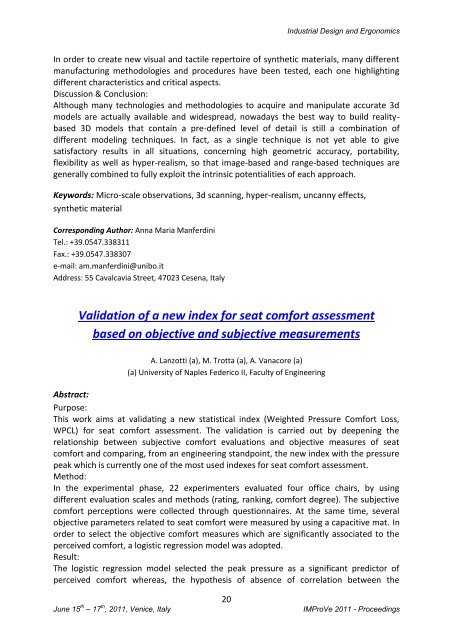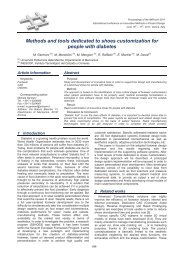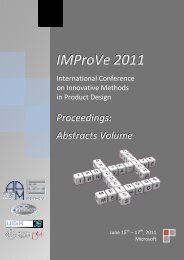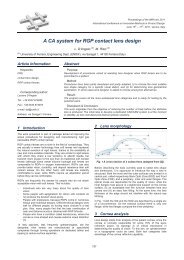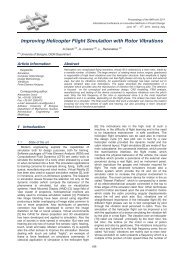IMProVe 2011 - Proceedings
IMProVe 2011 - Proceedings
IMProVe 2011 - Proceedings
Create successful ePaper yourself
Turn your PDF publications into a flip-book with our unique Google optimized e-Paper software.
Industrial Design and Ergonomics<br />
In order to create new visual and tactile repertoire of synthetic materials, many different<br />
manufacturing methodologies and procedures have been tested, each one highlighting<br />
different characteristics and critical aspects.<br />
Discussion & Conclusion:<br />
Although many technologies and methodologies to acquire and manipulate accurate 3d<br />
models are actually available and widespread, nowadays the best way to build realitybased<br />
3D models that contain a pre-defined level of detail is still a combination of<br />
different modeling techniques. In fact, as a single technique is not yet able to give<br />
satisfactory results in all situations, concerning high geometric accuracy, portability,<br />
flexibility as well as hyper-realism, so that image-based and range-based techniques are<br />
generally combined to fully exploit the intrinsic potentialities of each approach.<br />
Keywords: Micro-scale observations, 3d scanning, hyper-realism, uncanny effects,<br />
synthetic material<br />
Corresponding Author: Anna Maria Manferdini<br />
Tel.: +39.0547.338311<br />
Fax.: +39.0547.338307<br />
e-mail: am.manferdini@unibo.it<br />
Address: 55 Cavalcavia Street, 47023 Cesena, Italy<br />
Validation of a new index for seat comfort assessment<br />
based on objective and subjective measurements<br />
A. Lanzotti (a), M. Trotta (a), A. Vanacore (a)<br />
(a) University of Naples Federico II, Faculty of Engineering<br />
Abstract:<br />
Purpose:<br />
This work aims at validating a new statistical index (Weighted Pressure Comfort Loss,<br />
WPCL) for seat comfort assessment. The validation is carried out by deepening the<br />
relationship between subjective comfort evaluations and objective measures of seat<br />
comfort and comparing, from an engineering standpoint, the new index with the pressure<br />
peak which is currently one of the most used indexes for seat comfort assessment.<br />
Method:<br />
In the experimental phase, 22 experimenters evaluated four office chairs, by using<br />
different evaluation scales and methods (rating, ranking, comfort degree). The subjective<br />
comfort perceptions were collected through questionnaires. At the same time, several<br />
objective parameters related to seat comfort were measured by using a capacitive mat. In<br />
order to select the objective comfort measures which are significantly associated to the<br />
perceived comfort, a logistic regression model was adopted.<br />
Result:<br />
The logistic regression model selected the peak pressure as a significant predictor of<br />
perceived comfort whereas, the hypothesis of absence of correlation between the<br />
June 15 th – 17 th , <strong>2011</strong>, Venice, Italy<br />
20<br />
<strong>IMProVe</strong> <strong>2011</strong> - <strong>Proceedings</strong>


